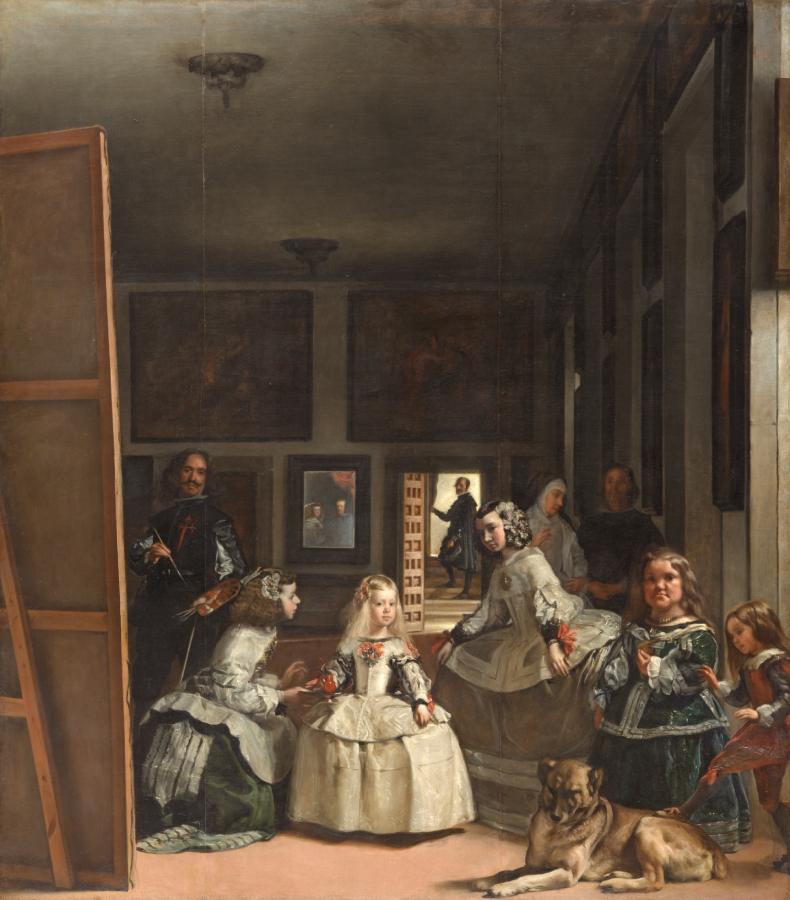Velázquez, Diego (1599-1660)
Las Meninas, o La familia de Felipe IV (Las meninas or The Family of Philip IV)
1656
Oil on canvas, 320.5 x 281.5 cm
Museo del Prado, Madrid
This is one of Velázquez‘s largest paintings and among those in which he made most effort to create a complex and credible composition that would convey a sense of life and reality while enclosing a dense network of meanings. The artist achieved his intentions and Las Meninas became the only work to which the writer on art Antonio Palomino devoted a separate section in his history of Spanish painters of 1724, entitling it In which the most illustrious work by Don Diego Velázquez is described. Since then the painting has never lost its status as a masterpiece. From Palomino we know that it was painted in 1656 in the Cuarto del Príncipe in the Alcázar in Madrid, which is the room seen in the work. He also identifies most of the figures of the court servants grouped around the Infanta Margarita, who is attended by two of the Queen’s meninas or maids-of honour: María Agustina Sarmiento and Isabel de Velasco. In addition to that group, we also see the artist himself working on a large canvas, the dwarves Mari Bárbola and Nicolasito Pertusato, the latter provoking a mastiff, and the lady-in-waiting Marcela de Ulloa next to a guardadamas (attendant), with the chamberlain José Nieto standing in the doorway in the background. Reflected in the mirror are the faces of Philip IV and Mariana of Austria, the Infanta‘s parents who are watching the scene taking place. The figures inhabit a space that is modelled not just through the laws of scientific perspective but also through aerial perspective. In the definition of this space the multiplication of the light sources plays an important role. Las Meninas has one meaning that is immediately obvious to any viewer: it is a group portrait set in a specific location and peopled with identifiable figures undertaking comprehensible actions. The painting’s aesthetic values are also evident: the setting is one of the most credible spaces depicted in western art; the composition combines unity and variety; the remarkably beautiful details are divided across the entire pictorial surface; and finally, the painter has taken a decisive step forward on the path to illusionism, which was one of the goals of European painting in the early modern age, given that he has gone beyond transmitting resemblance in order to successfully achieve the representation of life or animation. However, as is habitual with Velázquez, in this scene in which the Infanta and the court servants pause in their actions on the arrival of the King and Queen, there are numerous underlying meanings that pertain to different fields of experience and which co-exist in one of the masterpieces of western art that has been the subject of the most numerous and most varied interpretations. One study, for example, has focused on the royal status of the Infanta, which thus endows the entire painting with a political content. There are also, however, important references of an art-historical nature that are expressed through the presence of the painter himself and the paintings hanging on the rear wall, while the inclusion of the mirror makes this work a consideration on the act of seeing and ensures that the viewer reflects on the laws of representation, the limits between painting and reality and his or her own role within the painting. This richness and variety in the content, combined with the complexity of the painting’s composition and the variety of actions depicted, make Las Meninas a portrait in which the artist deploys representational strategies and pursues aims that go beyond the habitual ones in this genre, bringing it closer to history painting. In this sense, it is one of the key works through which Velázquez championed the potential of the pictorial genre to which he had devoted his activities since he arrived at court in 1623. (Portús Pérez, Javier, Diego Velázquez ‘Las Meninas’. En: Velázquez y la familia de Felipe IV, [1650-1680], Madrid, Museo Nacional del Prado, 2013, p.126-129 n.16)
See also:
• Felipe IV (1605-1665) | Margarita Teresa de Austria (1651-1673) | Mariana de Austria (1634-1696)
